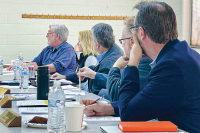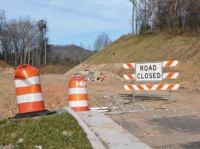Commissioners raise eyebrows over HCC building snags
The creative arts building at Haywood Community College has hit a few more snags on its way to completion — much to the chagrin of county commissioners.
The college will once again tap into its contingency fund to correct miscalculations resulting from either a lack of communication or a design faux pas. The project is still within its original budget, however.
The total project cost was estimated at about $10.2 million. A contingency fund was built into the price tag to cover unexpected costs that crop up during the course of construction, half of which has now been spent to fix several snags.
The commissioners agreed to allocate a little more than $25,000 to widen a doorway, reinforce an outside deck and construct a retaining wall as well as pay for a couple of minor miscellaneous items.
Rectifying the size of a doorway will consume about one-third of the money. The entry was too small to fit an absorption chiller, a piece of machinery that will allow the building to use solar energy to power its air conditioning.
“The architect has admitted an error,” said Bill Dechant, director of campus development. “When it is a (building) designer error, the architect or the designer is responsible for that item.”
Related Items
However, the county will have to foot the bill for now. Possible reimbursement is not negotiated until the end of a project. While the architect will likely repay the college some amount, it is not known how much money HCC will receive or even what mistakes the architect will claim.
“It’s hard to say” how much, if any, money the college will recoup, Dechant said.
The architect has been forthcoming in admitting errors, Dechant added.
Unfortunately, the sizing mistake was not caught until after the doorframe had already been installed.
“I don’t understand how they would have missed that,” Commissioner Mike Sorrells said at a county meeting last week, when the college came before commissioners asking for a budget adjustment on the project to tap contingency funds.
Although the widened doorframe is the priciest error, the board seemed most concerned about an inaccurate topographical survey that mapped how water drained around the building and where it should pave sidewalks. The contractor identified discrepancies between the survey and the land’s actual conditions, and a new survey needed to be conducted — a $2,000 cost.
HCC had hired the original surveyor, but when discrepancies were found, it did not ask the company to redo its survey for free or refund the money. The contractor’s on-hand surveyor reviewed the land at cost.
Commissioners agreed that the original surveyor should have returned and reevaluated the property at no cost.
“If the survey was wrong, you need to get the surveyor out there and correct it. That’s what I would do,” said Commissioner Kevin Ensley, a surveyor by profession. “And, I wouldn’t charge anybody for doing that.”
When Commissioner Chairman Mark Swanger made a motion to approve the added funds, none of the other commissioners immediately offered to second the motion.
“I am not hearing any explanation as to why someone else has not attempted to get someone else to pay for these things. And, I think that is what we want to here,” said Commissioner Kirk Kirkpatrick, after an awkward moment of silence.
Considering the scope of the project, Dechant said the total amount of change orders thus far is below average. Of the total project cost of $10.2 million, the construction contract is $8.6 million.
“In terms of an $8.6 million building, the amount of change orders on this project have been extremely low so far,” Dechant said. “I think overall I have been pleased with the amount of problems that we have had on this job.”
In the end, the county board voted to release the money.
Change orders take II
These were not the first design issues that have arisen during the already controversial project.
In January, Dechant went before the Haywood County Board of Commissioners seeking approval to use more than $262,000 in contingency funds. Most of it went to a water pump needed to provide adequate water pressure for the building’s sprinkler system.
Architects from the Raleigh-based Innovative Design erred when studying the water pressure earlier in the planning process. They tested the pressure in the main water lines running through campus a few hundred feet below the building site. As water flows up the hill to the new building, it loses pressure — a fact the architect did not factor into his plans, Dechant said at a previous commissioners meeting.
Last year, the commissioners and college administrators battled for months about the scope of the creative arts building project, before settling on a plan.
The new facility will house studio and classroom space for students studying the creative arts, such as pottery and woodwork.
“I know there was a lot of discussion about the building, and ‘Why this? Why that?’ And, I know my opinion, and I am sure the rest of the board’s opinion is too, is ‘How much more?’” Sorrells said.
Money to pay for the new building is coming from a quarter-cent sales tax approved by county voters more than four years ago to fund improvements to Haywood Community College’s campus.









